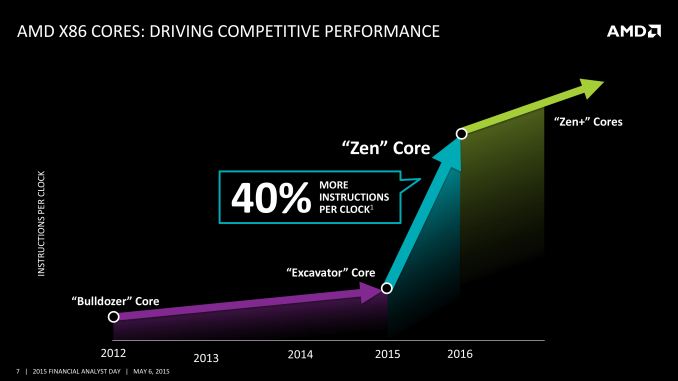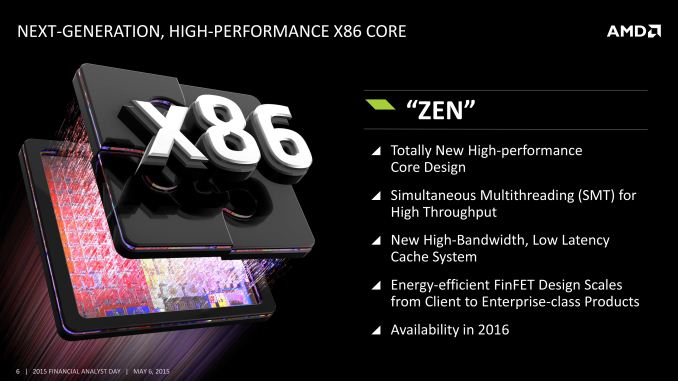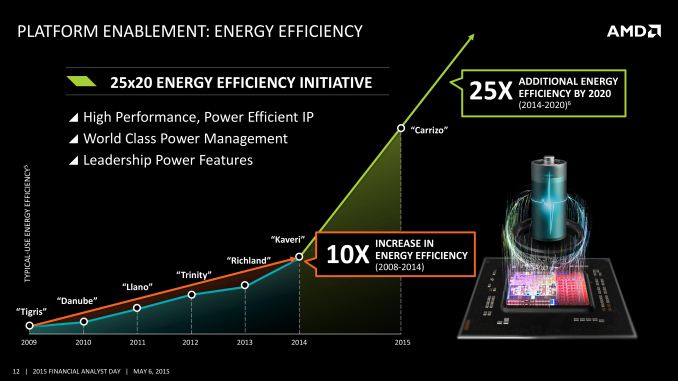AMD’s 2016-2017 x86 Roadmap: Zen Is In, Skybridge Is Out
by Ryan Smith on May 6, 2015 2:02 PM EST- Posted in
- CPUs
- AMD
- AMD FAD 2015
- Zen

AMD’s CTO Mark Papermaster just left the stage at AMD’s 2015 Financial Analyst Day, and one of the first things he covered was AMD’s CPU technology roadmap for the next couple of years.
The big question on everyone’s mind over the last year has been AMD’s forthcoming x86 Zen CPU, developed by Jim Keller’s group, and Papermaster did not disappoint, opting to address the future of AMD’s x86 plans first and foremost. AMD is not releasing the complete details on Zen until closer to its launch in 2016, but today they are providing some basic details on the CPU’s abilities and their schedule for it.
In terms of features, AMD once again confirmed that they’re aiming for significantly higher performance, on the order of a 40% increase in Instruction Per Clock (IPC) throughput. In a significant shift in threading for AMD’s x86 CPUs, Zen will also shift from Bulldozer’s Clustered Multithreading (CMT) to Simultanious Multithreading (SMT, aka Intel’s Hyperthreading). CMT is the basis for Bulldozer’s unusual combination of multiple integer cores sharing a single FPU within a module, so the move to SMT is a more “traditional” design for improving resource usage, and it means Zen will similarly have a more traditional resource layout. AMD is also labeling Zen’s cache as a “high-bandwidth, low latency cache system,” though at this time they aren’t quantifying just how that differs from the Dozer family’s cache.
Meanwhile AMD has confirmed that Zen will be shipping in 2016, and that it will be produced on a yet-to-be-named FinFET process. Our bet would be that AMD continues to use traditional partner (and spin-off fab) GlobalFoundries, who will be ramping up their 14nm equipment for next year as part of their licensing/partnership with Samsung to implement Samsung’s 14nm FinFET process. Zen at this time is AMD’s priority, to the point where the company is willing to push back the ARM K12 in order to get Zen out the door first.
Desktop users will be happy to know that the first Zen processor out the door will be AMD’s high-end desktop CPU (AMD was very deliberate in this, it’s not an APU). AMD will be aiming high and then cascading Zen down into APUs and lower-end products.
Said Zen CPU will use a new AMD platform – AM4 – which will also support DDR4. Unlike the Dozer family, all of AMD’s desktop CPUs will use the same AM4 platform/socket, so when AMD does ramp up their Zen APU, it too will be on AM4 and not its own socket, simplifying the process.
Finally, AMD’s roadmap for Zen over 2016-2017 calls for further improved Zen cores, “Zen+”, later on. Though the biggest jump for AMD comes from the transition from Dozer to Zen, the company is looking to push the envelope on IPC harder than they did with the Dozer family, projecting a higher increase in IPC over time than what we saw with the Dozer parts.
As for what this means for single-threaded performance, that remains to be seen. After having chased a lower-IPC/higher-clockspeed strategy in an attempt to do something different from Intel – the AMD that designed Bulldozer thought it wise not to try to beat well-funded Intel at their own game – the focus on higher IPC is arguably the correct move to make as the laws of physics have continued to keep 5GHz+ clockspeeds from being efficient enough to be practical. That said, single-threaded performance is a combination of IPC and clockspeed, so to be competitive with Intel AMD needs to deliver higher IPC while maintaining relatively high clockspeeds, and the latter is not something AMD is disclosing this early in the process.
Finally, we’ll note that this roadmap is empty of any mentions of project Skybridge. CEO Lisa Su has commented that AMD has decided to change their focus away from Skybridge based on customer feedback. Customers were telling AMD that they didn't necessarily need socket compatible solutions, so AMD is going to work on differentiated solutions. That said, given that Skybridge was announced last year and planned for 20nm, I suspect that it has also become a victim of the short lifespan (and underperforming nature) of 20nm, leading to it being downplayed in favor of 14nm prodcts.
Meanwhile also absent was any further mention of AMD's Cat cores. Zen would appear to be AMD’s top-to-bottom x86 core, a significant departure from an AMD who previously wanted separate designs for the 10W-100W market and sub-10W markets.














59 Comments
View All Comments
Samus - Wednesday, May 6, 2015 - link
I hope Samsung can turn AMD's manufacturing around.bill.rookard - Wednesday, May 6, 2015 - link
While I certainly would like to see a competitive AMD, and a good focus on a good CPU, I'm curious if their 'single core to rule them' strategy is going to be effective. That would be dependent on the big question: will it scale?Considering that Intel has decidedly different types of cores for their desktop (Haswell) and mobile (Atom), that has to hint that there can be some serious issues in trying to scale a single design from 2 to 50 watts.
RussianSensation - Wednesday, May 6, 2015 - link
Let's face it, most of people on AT don't care about Atom processors. If AMD can become more competitive in the 15W-95W space, it's what most people on here want. The limited market segments where Intel targets Atoms is not worth competing in anyway since Intel basically uses contra-revenue and gives the Atom away to push certain products (Asus Zenphone 2). You cannot compete in that segment to start with against a company that can lose $3-4 billion a year giving away lower power SoCs.xthetenth - Wednesday, May 6, 2015 - link
Intel's already got their big core scaling out of AMD's likely comfort zone, although a Zen derivative with HBM power savings and an agressive price point might make a compelling competitor to Core M. Going for Atom's space against established ARM solutions and strongly financially backed designs by Intel with a chip that is neither seems to be a folly for a company that has to pick battles.chizow - Wednesday, May 6, 2015 - link
Intel just got the Atom into another important design win, the Surface 3. If you read that review you'd notice AMD did not have a single device that could even be benchmarked in that comparison. They're not even in the game.While you may think Intel is dealing in a market that isn't even profitable to them, the benchmarks should tell you an entirely differently story. They are competing in that market and breaking even on the chips to PREVENT their competition from completely dominating the low-end, thus preventing any chance of those platforms growing enough to cannibilize their high-end lucrative x86 desktop and server market.
Basically, they are paying a small fee to ensure x86 dominance remains intact. They have billions of PROFITS riding on that, every quarter.
testbug00 - Wednesday, May 6, 2015 - link
breaking even on the chips and than giving the people who use the chips money isn't breaking even.I suspect the only reason that the Surface 3 is x86 is because the problem with the original two surfaces was ARM. If Microsoft just wanted to make a tablet/office device, going ARM would have been cheaper, faster and lower power.
However, they are fixing the problems that the original surface and surface two had, not being able to run all the windows applications.
RussianSensation - Wednesday, May 6, 2015 - link
"Basically, they are paying a small fee to ensure x86 dominance remains intact." $3-4 billion losses in that market segment is not a small fee. As mentioned by xthetenth, for us gamers and majority of laptop/desktop markets, the most important segments are 15-95W.Most people are happy with their iPads anyway so who cares about the Surface Pro. Surface Pro targets just 1 type of a consumer. AMD has limited funds and its better to focus on the core market segments where it has a shot.
AMD is smart enough to know they cannot compete when Intel gives away for free or pays subsidies to Lenovo and Asus to include Atom in their smartphones. You know exactly what my post meant. Atom is making no money for Intel in the smartphones as Intel is basically giving it away to establish the brand.
http://www.phonearena.com/news/Lenovo-K80-features...
ZenPhone 2 will have a $100 off discount for 1 day too. AMD could waste $10 billion dollars in trying to get an Atom competitor and would lose.
lilmoe - Wednesday, May 6, 2015 - link
"Most people are happy with their iPads anyway"Fads come and go. What remains is value. Just like testbug00 said; the problem wasn't a stale and "unwanted" market segment, it was Microsoft. Now that Microsoft has their sh!t together, we'll be seeing demand shifting to the low end x86 gradually.
chizow - Wednesday, May 6, 2015 - link
That statement is nonsense anyways, iPad sales are declining every quarter because people are happy with the one iPad they bought, but in general tablet interest is waning because of the limitations of those toy OS platforms like iOS and Android.That's where the Surface steps in, and that's where Microsoft and Intel stand to profit. There's not 1 person who wants a Surface, they're for anyone who wants something that can do more than a toy tablet.
Crunchy005 - Wednesday, May 6, 2015 - link
L A P T O P SI like the surface 3s. They are awesome. But for me I have not been able to justify a tablet at all, i'm probably a minority or rational, and so my macbook air (awesome lightweight laptop) and desktop works fine for me. There are a ton of laptop designs AMD can win with zen and even hoping a few for APUs now that the wattage is down with carrizo. Laptop sales are doing fine, and the desktop may even come back who knows. O and surface competition is out there, the Yoga is one example.
For those with Ipads they are great and work in conjunction with another computer which most people have. I even know people who use just IPads with no other computer. I would love to see a full OS like the surface but the surface is the way it is because lets face it the Microsoft app store has all of 50 apps. When they hit page two on the "all apps" page there will be huge celebrations from users. ARM devices are great don't sell them short @chizow. The Atom processor on the other hand is so broken Intel has to give it away, now of course AMD can't compete against that. Free vs. pay for chip. OEMs are greedy and will choose the free/almost free chip for greater profits for themselves. This is not profit for Intel.
Also if Zen can compete against the M cores, i'm hoping they aren't as broken as core M is.